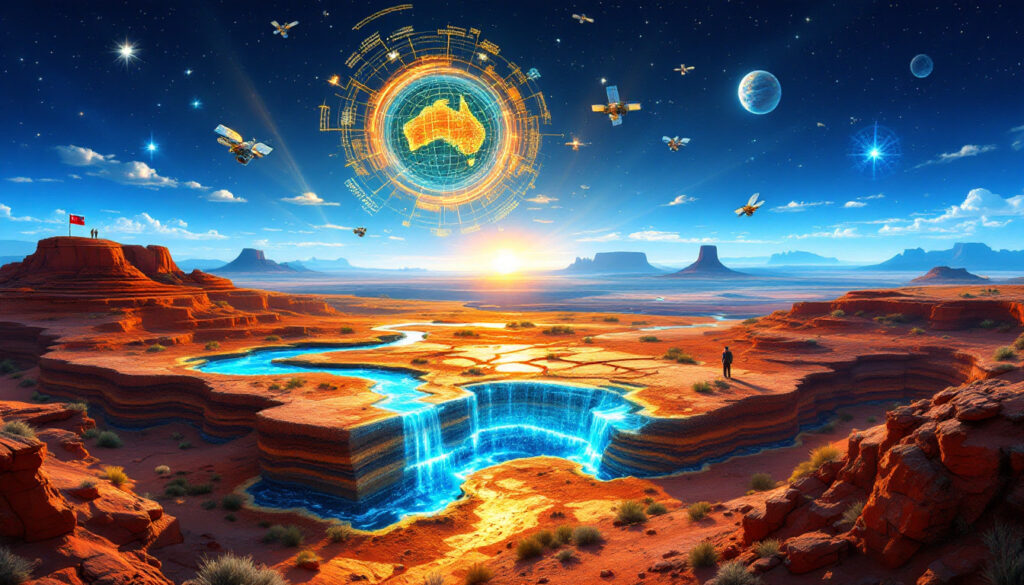What is Earth Science and Why Does It Matter in Australia?
Earth science encompasses the study of our planet's physical properties, systems, and processes. It delves into geology, meteorology, oceanography, and atmospheric science to understand how Earth functions as an integrated system. In Australia, a continent with unique landscapes spanning 8.9 million square kilometers of land and marine jurisdictions, earth science in Australia forms the foundation of our understanding of the environment we inhabit.
Geoscience Australia serves as the nation's premier government agency responsible for providing authoritative earth science information. Their work extends beyond research to practical applications that affect millions of Australians daily, from mapping coastlines to identifying mineral resources that drive the economy.
"Earth science is everywhere and for everyone," as earth scientists frequently emphasize. This statement reflects how deeply earth science permeates Australian society, from the resources we extract to the infrastructure we build.
The Fundamental Role of Earth Science in Australian Society
Australia's identity is inseparable from its geology. From the ancient rocks of the Pilbara dating back 3.6 billion years to the relatively young volcanic formations of Victoria, our landscape tells a story that earth scientists help decode. This geological diversity has blessed Australia with abundant natural resources that constitute approximately 14% of the nation's GDP, contributing around AU$372 billion annually to the economy.
The insights provided by earth scientists guide decision-making across countless sectors, including mining, agriculture, construction, and environmental management. Their expertise helps identify not only where valuable resources exist but also how to extract them sustainably.
Earth science research informs our understanding of natural hazards such as bushfires, floods, and cyclones, enabling communities to build resilience against these threats. This knowledge becomes increasingly valuable as climate patterns shift and extreme weather events become more frequent.
Beyond Rocks: Earth Science in Everyday Australian Life
Many Australians might be surprised to learn that earth science touches nearly every aspect of daily life. The copper wiring carrying electricity to approximately 85% of Australian homes originated from deposits identified through geology of ore deposits. The aluminum in your kitchen foil, the gold in electronic devices, and even the rare earth elements in smartphone screens—all these materials were located and extracted using earth science principles.
When you order pizza delivery, the driver navigates using GPS technology that relies on precise coordinate systems developed by geospatial scientists. The water flowing from your tap likely came from reservoirs or aquifers identified and monitored by hydrogeologists. Even the planning of your local shopping center required geotechnical assessments to ensure safe construction.
Australia's resource-based economy particularly depends on earth science. The industry employs thousands directly and many more indirectly, creating pathways for regional development and international trade relationships. Mining exports represent over half of Australia's total export value, highlighting the economic significance of earth science knowledge.
How Does Earth Science Support Australia's Sustainable Future?
As the world moves toward renewable energy and sustainable technologies, Australia's earth science expertise becomes increasingly valuable. The transition to clean energy requires unprecedented quantities of specific minerals—creating both opportunities and responsibilities for Australia as a major resource provider.
Critical Minerals for Green Energy Transition
Australia holds approximately 21% of the world's lithium reserves, positioning the nation as a crucial supplier for the global green energy transition. This lightweight metal forms an essential component in batteries for electric vehicles and renewable energy storage systems. As global demand for electric vehicles rises, an estimated 60 million tonnes of cobalt will be required by 2030—and Australia possesses significant reserves of this critical mineral.
Wind turbines require rare earth elements for their generators, while solar panels depend on high-purity silicon and various metals. Even the transmission infrastructure needed to deliver renewable energy relies on copper and aluminum, both abundant in Australia. Earth scientists are working to identify new deposits of these minerals while developing more efficient and environmentally sensitive extraction methods.
"Earth science is essential to ensure we have enough materials for a sustainable future," notes the transcript from Geoscience Australia. This statement underscores the paradox that renewable energy development requires responsible mining—a balance that earth scientists help maintain through research and technological innovation.
The SunCable Project in the Northern Territory exemplifies this relationship, using lithium sourced from Australian mines to power massive solar farms that could eventually export clean energy to Singapore, demonstrating how Australia's lithium ambitions directly enables green energy development.
Water Resource Management in a Dry Continent
Australia's reputation as the driest inhabited continent makes water management a critical application of earth science. Hydrogeologists employ airborne electromagnetic surveys to identify and map more than 30 major aquifers across the country, providing crucial information for sustainable water extraction.
Subsurface imaging technologies allow scientists to visualize complex underground water systems without extensive drilling. These non-invasive methods help identify groundwater potential in regions where surface water is scarce or unreliable, improving water security for approximately 2 million regional Australians.
The Great Artesian Basin, one of the world's largest underground water reservoirs, sustains around 180,000 rural residents and their agricultural activities. Earth scientists monitor this vital resource, tracking water levels, quality, and recharge rates to ensure its long-term viability.
Climate models developed by earth scientists help predict rainfall patterns, allowing water authorities to plan accordingly for droughts and wet seasons. These forecasts inform decisions about water restrictions, dam management, and environmental flows, supporting both human communities and ecological systems.
What Technologies Are Advancing Earth Science in Australia?
Technological innovation continues to transform how earth scientists collect, analyze, and apply data. These advancements enable more accurate predictions, better resource management, and enhanced disaster response capabilities.
Satellite Observation and Environmental Monitoring
Over three decades of Landsat satellite imagery has created an invaluable record of Australia's changing landscape. This long-term dataset allows scientists to track environmental transformations, including a documented 12% coastal erosion along parts of Queensland's shoreline. The continuous nature of these observations provides insights into both natural processes and human impacts.
Satellite monitoring enables real-time bushfire detection, with systems like the Japanese Himawari-8 satellite providing alerts every 10 minutes. During the catastrophic 2019-2020 bushfire season, this technology helped emergency services respond more efficiently, potentially saving lives and property.
Multispectral imaging from satellites tracks mangrove recovery following El Niño events, measuring approximately 15% regrowth in affected areas. This information helps scientists understand ecosystem resilience and recovery patterns, informing conservation efforts and land management decisions.
Earth observation satellites also monitor agricultural productivity, urban expansion, and mining activities, providing objective data to inform policy decisions. The Digital Earth Australia program makes this satellite data freely available, democratizing access to earth science information for researchers, businesses, and community groups.
Precision Location Technologies
Australia leads advances in global navigation satellite system (GNSS) technology, achieving positioning accuracy within 2 centimeters. This precision supports autonomous vehicles in mining operations, such as Rio Tinto's automated trucks operating in the Pilbara region.
"Scientists are working to make location information accurate to the centimeter scale," notes the transcript, reflecting ongoing efforts to refine Australia's positioning infrastructure. This work underpins innovations in agriculture (precision farming), transportation (autonomous vehicles), and construction (automated machinery).
The improved accuracy enables better mapping of property boundaries, reducing disputes and supporting efficient land administration. Emergency services benefit from enhanced location capabilities when responding to natural disasters or search-and-rescue operations in remote areas.
Future applications of these technologies include improved navigation for visually impaired individuals, more efficient urban planning, and enhanced monitoring of environmental changes like coastal erosion and land subsidence. Additionally, digital twins in mining are revolutionizing how companies visualize and optimize their operations in real-time.
How Does Earth Science Help Australia Address Environmental Challenges?
Australia faces unique environmental challenges due to its climate, geography, and susceptibility to natural disasters. Earth science provides crucial tools for understanding these challenges and developing effective responses.
Climate Adaptation and Resilience
Research indicates that approximately 39% of Australia's coastline faces risk from a projected 0.8-meter sea-level rise by 2100. Earth scientists use high-resolution elevation models to identify vulnerable areas, helping communities plan for future changes through infrastructure design, coastal protection measures, and managed retreat where necessary.
Earth science data informs Australia's National Climate Resilience Plan by providing detailed assessments of how different regions will experience climate change impacts. This granular understanding allows for targeted adaptation strategies rather than one-size-fits-all approaches.
Long-term monitoring of environmental indicators—from soil moisture to ocean temperatures—creates baseline data that helps distinguish natural variability from climate change impacts. This distinction proves crucial for developing effective adaptation policies and prioritizing limited resources.
Earth scientists also work with engineers and urban planners to design climate-resilient infrastructure, considering factors like future flood levels, changed wind patterns, and increased bushfire risk. These collaborations ensure that major investments in roads, bridges, and public buildings remain functional despite changing environmental conditions.
Disaster Risk Reduction and Emergency Response
Bushfire prediction models informed by earth science have reduced emergency response times by up to 40% in New South Wales. These models integrate topographic data, vegetation analysis, and weather forecasts to predict fire spread patterns, allowing more efficient deployment of firefighting resources.
Flood modeling using 2D hydraulic simulations helps protect approximately 500,000 properties in flood-prone areas like Brisbane. The 2022 Lismore floods demonstrated both the challenges and the value of accurate terrain mapping through LiDAR technology, which provided crucial elevation data for emergency planning.
Australia maintains a network of 12 real-time tsunami detection buoys monitoring seismic activity along the Indo-Australian Plate. This early warning system gives coastal communities precious minutes to evacuate when necessary, potentially saving countless lives.
Earth scientists provide critical information during all phases of disaster management—before (risk assessment), during (real-time monitoring), and after (impact assessment and recovery planning). Their expertise helps communities rebuild in ways that reduce vulnerability to future events, creating a cycle of continuous improvement in disaster resilience.
What Career Opportunities Exist in Australian Earth Sciences?
The diverse applications of earth science create numerous career pathways for those interested in understanding our planet while contributing to society's wellbeing. Industry forecasts predict an 18% increase in geoscientist roles by 2030, reflecting growing demand for this expertise.
Diverse Pathways in Earth Science Fields
Australia offers 27 university programs in earth science disciplines, with leading institutions including the Australian National University and the University of Western Australia. These educational pathways range from traditional geology degrees to specialized programs in remote sensing, hydrogeology, and environmental geoscience.
Career opportunities span government agencies (Geoscience Australia, CSIRO), private industry (mining, environmental consulting), research institutions, and non-profit organizations. Roles vary from field-based positions collecting data to laboratory analysts and computational scientists developing models and simulations.
The integration of artificial intelligence with earth science has created new specialized roles. Machine learning algorithms now identify mineral deposits with 92% accuracy, transforming exploration techniques and creating demand for professionals with both geoscience and data science expertise.
In drought-affected regions, demand for hydrogeologists has increased by 33%, highlighting how environmental challenges drive job creation in specialized fields. Similar growth occurs in coastal management, renewable energy site assessment, and carbon sequestration research.
Innovation and Future Directions
Collaboration between industry and academia creates exciting opportunities for earth scientists. The CSIRO-UNSW partnership on carbon capture technology exemplifies how research can address climate challenges while creating new career pathways. Similar initiatives exist in critical minerals, hydrogen energy, and advanced materials.
Emerging roles for marine geologists supporting offshore wind farm installations demonstrate how renewable energy transitions create demand for specialized earth science expertise. These positions require understanding of seafloor conditions, sediment dynamics, and potential environmental impacts.
"Earth science is for everyone," the transcript emphasizes, reflecting the field's increasingly diverse and inclusive nature. Modern earth science integrates traditional knowledge with cutting-edge technology, creating space for varied perspectives and approaches to understanding our planet.
Australia's potential leadership in global earth science initiatives depends on continued investment in education, research, and infrastructure. Current funding programs aim to address gender diversity in mining sectors and increase participation of underrepresented groups in earth science education. Furthermore, AI-powered fleet management and decarbonisation in mining are creating new technological frontiers in the industry.
FAQ About Earth Science in Australia
What is the difference between earth science and geology?
Earth science encompasses a broader scope than geology, functioning as an umbrella term for multiple disciplines studying our planet. While geology focuses specifically on Earth's solid materials, structure, and history, earth science also includes oceanography (oceans), meteorology (atmosphere), and hydrology (water systems).
These disciplines overlap and interact—a volcanologist (geologist) might collaborate with atmospheric scientists to understand how eruptions affect climate, or with oceanographers to study underwater volcanoes. This interdisciplinary approach reflects Earth's nature as an integrated system.
In Australian universities, students often begin with general earth science courses before specializing in specific fields like economic geology, geophysics, or environmental geoscience. This educational approach acknowledges both the distinctiveness of each discipline and their fundamental interconnections.
How does earth science contribute to Australia's economy?
Earth science makes both direct and indirect economic contributions to Australia. Direct contributions include resource identification and extraction, with mining alone representing approximately 14% of GDP (AU$372 billion annually) and creating thousands of jobs across the country.
Indirect economic benefits come through infrastructure planning, where geotechnical assessments prevent costly construction failures. Hazard mitigation informed by earth science saves billions in potential disaster damages annually, while accurate weather predictions support agricultural production worth over AU$60 billion each year.
Long-term economic sustainability depends on informed resource management—knowing not just where minerals exist but how to extract them efficiently while minimizing environmental impacts. Earth scientists also identify opportunities for value-adding industries, helping Australia move beyond raw material exports to advanced manufacturing and technology development.
What educational paths lead to earth science careers in Australia?
Australian universities offer diverse pathways into earth science careers, with 27 institutions providing relevant undergraduate and postgraduate programs. Entry typically requires strong foundations in mathematics, chemistry, and physics, reflecting the field's increasingly quantitative nature.
Vocational education and training (VET) programs provide technical skills for roles like geological technicians, field assistants, and laboratory analysts. These qualifications often serve as stepping stones to further education or specialized industry certifications.
Professional development continues throughout earth science careers, with peak bodies like the Australian Institute of Geoscientists offering continuing education programs. Industry-specific training ranges from software applications to field techniques and regulatory compliance.
Recent curriculum innovations include indigenous knowledge integration, ensuring future earth scientists understand both Western scientific methods and traditional approaches to land and resource management. This educational evolution reflects growing recognition that multiple knowledge systems strengthen our understanding of complex earth systems.
How is earth science helping Australia address climate change?
Earth scientists provide essential data for climate change response through environmental monitoring, helping Australia track changes in temperature patterns, rainfall distribution, and extreme weather frequency. This information underpins both mitigation strategies and adaptation planning.
In renewable energy development, earth scientists identify optimal sites for solar, wind, and hydroelectric installations while ensuring responsible sourcing of minerals required for clean energy technologies. Their expertise supports Australia's transition toward net-zero emissions while maintaining economic prosperity.
Adaptation strategies rely heavily on earth science information, from sea-level rise projections informing coastal development policies to bushfire risk assessments guiding vegetation management. This evidence-based approach ensures resources target the most vulnerable areas and communities.
Earth scientists also help identify natural carbon sequestration opportunities through technologies like mineral carbonation, where certain rock types chemically absorb carbon dioxide. These innovative approaches complement conventional emission reduction strategies, potentially accelerating Australia's path to climate targets while creating new industries and employment opportunities.
Looking for Actionable Insights into Earth Science Opportunities in Australia?
Discover real-time alerts on significant ASX mining and resource opportunities through Discovery Alert's proprietary Discovery IQ model, transforming complex geological data into actionable investment insights. Explore how major mineral discoveries can lead to significant market returns by visiting Discovery Alert's dedicated discoveries page and position yourself ahead of the market.




